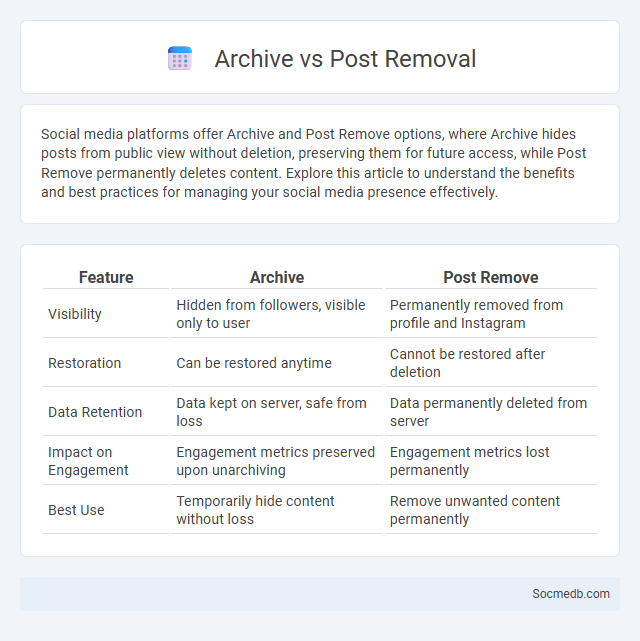
Photo illustration: Archive vs Post Remove
Social media platforms offer Archive and Post Remove options, where Archive hides posts from public view without deletion, preserving them for future access, while Post Remove permanently deletes content. Explore this article to understand the benefits and best practices for managing your social media presence effectively.
Table of Comparison
| Feature | Archive | Post Remove |
|---|---|---|
| Visibility | Hidden from followers, visible only to user | Permanently removed from profile and Instagram |
| Restoration | Can be restored anytime | Cannot be restored after deletion |
| Data Retention | Data kept on server, safe from loss | Data permanently deleted from server |
| Impact on Engagement | Engagement metrics preserved upon unarchiving | Engagement metrics lost permanently |
| Best Use | Temporarily hide content without loss | Remove unwanted content permanently |
Understanding Archive and Post Remove Functions
The Archive function on social media platforms allows users to hide posts from their public profile without deleting them, preserving content for personal reference while maintaining a clean feed. Post removal permanently deletes the content, eliminating any possibility of recovery or future access by the user or followers. Understanding these options helps users manage their digital footprint effectively, balancing content visibility with privacy concerns.
Archive vs Post Remove: Key Differences
Archive and post removal serve distinct functions in social media management: archiving hides a post from public view while preserving it for personal access, whereas post removal permanently deletes the content from the platform. Archiving enables users to temporarily restrict visibility without losing comments or likes, maintaining engagement metrics for future restoration. Post removal results in irreversible content loss, eliminating all associated data and engagement history from the account and feed.
When Should You Archive Content?
You should archive content on social media when it no longer reflects your current brand identity or marketing strategy but still holds value for future reference. Archiving helps maintain a clean and engaging feed while preserving posts that may become relevant later for trends, promotions, or analytical insights. Evaluate your audience engagement metrics regularly to decide which content is best archived to optimize your social media presence effectively.
Benefits of Using Archive on Social Platforms
Using the archive feature on social media platforms allows you to preserve valuable content without permanently deleting it, ensuring your profile remains clean and organized. Archived posts can be easily restored or reviewed later, which helps maintain a cohesive online presence while protecting memories and important information. This tool enhances your ability to manage your digital footprint efficiently and strategically.
What Happens When You Remove a Post?
Removing a post on social media immediately deletes it from public view and prevents others from interacting with the content, such as liking, commenting, or sharing. However, depending on the platform's policies, residual data like cached versions or third-party screenshots might persist. Your digital footprint may still be traceable through saved backups or search engine caches even after deletion.
Archive vs Delete: Impact on Data & Visibility
Archiving social media content preserves data and maintains post visibility within private user settings, allowing for future retrieval without public exposure. Deleting content permanently removes data from the platform, eliminating all traces and reducing the user's digital footprint. Choosing between archive and delete impacts data retention policies, user privacy, and content discoverability across social networks.
How to Decide: Archive, Remove, or Delete?
Evaluating whether to archive, remove, or delete social media content depends on the goals of digital management and privacy concerns. Archiving preserves the content for future reference without public visibility, ideal for users needing historical access or documentation. Removing hides posts from public view but retains data on the platform, while deleting permanently erases content, ensuring complete data removal and enhanced privacy protection.
Restoring Archived Content: Is It Possible?
Restoring archived content on social media platforms depends on the specific service's data retention policies and user permissions; some platforms allow users to recover deleted posts within a limited timeframe through archive or trash features. Third-party data recovery tools may assist in some cases, but success varies based on how long the content has been archived and deleted. Understanding each platform's archival system, such as Instagram's Archive feature or Facebook's Activity Log, is essential to maximize restoration possibilities.
Privacy Considerations: Archive vs Post Remove
When managing your social media presence, understanding the privacy implications of archiving versus deleting posts is crucial. Archiving hides your content from public view while preserving it for your personal access and future restoration, maintaining data integrity without exposure risk. Removing posts completely erases your data from the platform, reducing potential privacy breaches but eliminating any possibility of content recovery.
Best Practices for Managing Online Content
Effective management of online content requires regular scheduling and consistent posting to maintain audience engagement and boost your social media presence. Prioritize high-quality visuals, clear messaging, and relevant hashtags to enhance discoverability and interaction with your target demographic. Monitoring analytics enables you to refine content strategies, optimize reach, and ensure your social media platforms consistently reflect your brand's goals.
 socmedb.com
socmedb.com